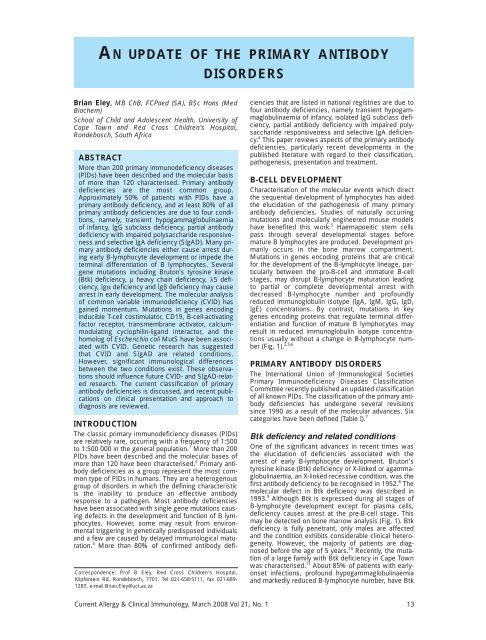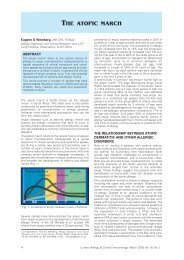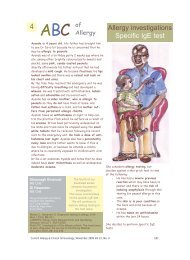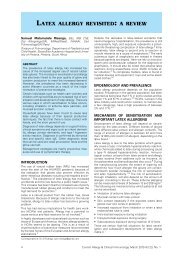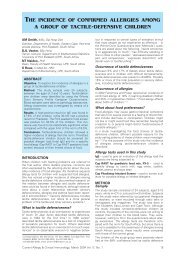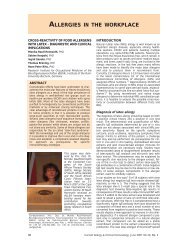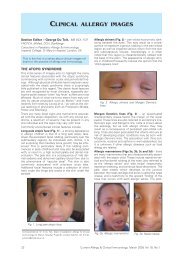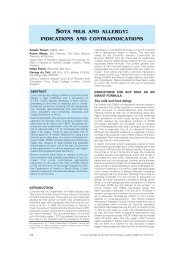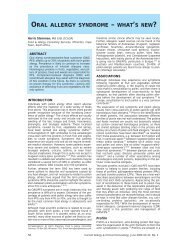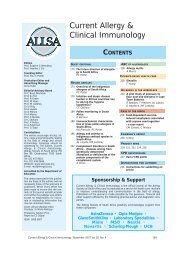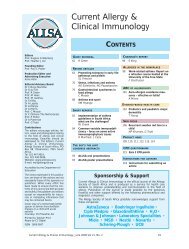Current Allergy and Clinical Immunology - March 2008
Current Allergy and Clinical Immunology - March 2008
Current Allergy and Clinical Immunology - March 2008
You also want an ePaper? Increase the reach of your titles
YUMPU automatically turns print PDFs into web optimized ePapers that Google loves.
AN UPDATE OF THE PRIMARY ANTIBODYDISORDERSBrian Eley, MB ChB, FCPaed (SA), BSc Hons (MedBiochem)School of Child <strong>and</strong> Adolescent Health, University ofCape Town <strong>and</strong> Red Cross Children’s Hospital,Rondebosch, South AfricaABSTRACTMore than 200 primary immunodeficiency diseases(PIDs) have been described <strong>and</strong> the molecular basisof more than 120 characterised. Primary antibodydeficiencies are the most common group.Approximately 50% of patients with PIDs have aprimary antibody deficiency, <strong>and</strong> at least 80% of allprimary antibody deficiencies are due to four conditions,namely, transient hypogammaglobulinaemiaof infancy, IgG subclass deficiency, partial antibodydeficiency with impaired polysaccharide responsiveness<strong>and</strong> selective IgA deficiency (SIgAD). Many primaryantibody deficiencies either cause arrest duringearly B-lymphocyte development or impede theterminal differentiation of B lymphocytes. Severalgene mutations including Bruton’s tyrosine kinase(Btk) deficiency, µ heavy chain deficiency, λ5 deficiency,Igα deficiency <strong>and</strong> Igβ deficiency may causearrest in early development. The molecular analysisof common variable immunodeficiency (CVID) hasgained momentum. Mutations in genes encodinginducible T-cell costimulator, CD19, B-cell-activatingfactor receptor, transmembrane activator, calciummodulatingcyclophilin-lig<strong>and</strong> interactor, <strong>and</strong> thehomolog of Escherichia coli MutS have been associatedwith CVID. Genetic research has suggestedthat CVID <strong>and</strong> SIgAD are related conditions.However, significant immunological differencesbetween the two conditions exist. These observationsshould influence future CVID- <strong>and</strong> SIgAD-relatedresearch. The current classification of primaryantibody deficiencies is discussed, <strong>and</strong> recent publicationson clinical presentation <strong>and</strong> approach todiagnosis are reviewed.Correspondence: Prof B Eley, Red Cross Children's Hospital,Klipfontein Rd, Rondebosch, 7701. Tel 021-658-5111, fax 021-689-1287, e-mail Brian.Eley@uct.ac.zaINTRODUCTIONThe classic primary immunodeficiency diseases (PIDs)are relatively rare, occurring with a frequency of 1:500to 1:500 000 in the general population. 1 More than 200PIDs have been described <strong>and</strong> the molecular bases ofmore than 120 have been characterised. 2 Primary antibodydeficiencies as a group represent the most commontype of PIDs in humans. They are a heterogenousgroup of disorders in which the defining characteristicis the inability to produce an effective antibodyresponse to a pathogen. Most antibody deficiencieshave been associated with single gene mutations causingdefects in the development <strong>and</strong> function of B lymphocytes.However, some may result from environmentaltriggering in genetically predisposed individuals<strong>and</strong> a few are caused by delayed immunological maturation.3 More than 80% of confirmed antibody deficienciesthat are listed in national registries are due tofour antibody deficiencies, namely transient hypogammaglobulinaemiaof infancy, isolated IgG subclass deficiency,partial antibody deficiency with impaired polysaccharideresponsiveness <strong>and</strong> selective IgA deficiency.4 This paper reviews aspects of the primary antibodydeficiencies, particularly recent developments in thepublished literature with regard to their classification,pathogenesis, presentation <strong>and</strong> treatment.B-CELL DEVELOPMENTCharacterisation of the molecular events which directthe sequential development of lymphocytes has aidedthe elucidation of the pathogenesis of many primaryantibody deficiencies. Studies of naturally occurringmutations <strong>and</strong> molecularly engineered mouse modelshave benefited this work. 5 Haemapoeitic stem cellspass through several developmental stages beforemature B lymphocytes are produced. Development primarilyoccurs in the bone marrow compartment.Mutations in genes encoding proteins that are criticalfor the development of the B-lymphocyte lineage, particularlybetween the pro-B-cell <strong>and</strong> immature B-cellstages, may disrupt B-lymphocyte maturation leadingto partial or complete developmental arrest withdecreased B-lymphocyte number <strong>and</strong> profoundlyreduced immunoglobulin isotype (IgA, IgM, IgG, IgD,IgE) concentrations. By contrast, mutations in keygenes encoding proteins that regulate terminal differentiation<strong>and</strong> function of mature B lymphocytes mayresult in reduced immunoglobulin isotype concentrationsusually without a change in B-lymphocyte number(Fig. 1). 2,5,6PRIMARY ANTIBODY DISORDERSThe International Union of Immunological SocietiesPrimary Immunodeficiency Diseases ClassificationCommittee recently published an updated classificationof all known PIDs. The classification of the primary antibodydeficiencies has undergone several revisionssince 1990 as a result of the molecular advances. Sixcategories have been defined (Table I). 7Btk deficiency <strong>and</strong> related conditionsOne of the significant advances in recent times wasthe elucidation of deficiencies associated with thearrest of early B-lymphocyte development. Bruton'styrosine kinase (Btk) deficiency or X-linked or agammaglobulinaemia,an X-linked recessive condition, was thefirst antibody deficiency to be recognised in 1952. 8 Themolecular defect in Btk deficiency was described in1993. 9 Although Btk is expressed during all stages ofB-lymphocyte development except for plasma cells,deficiency causes arrest at the pre-B-cell stage. Thismay be detected on bone marrow analysis (Fig. 1). Btkdeficiency is fully penetrant, only males are affected<strong>and</strong> the condition exhibits considerable clinical heterogeneity.However, the majority of patients are diagnosedbefore the age of 5 years. 10 Recently, the mutationof a large family with Btk deficiency in Cape Townwas characterised. 11 About 85% of patients with earlyonsetinfections, profound hypogammaglobulinaemia<strong>and</strong> markedly reduced B-lymphocyte number, have Btk<strong>Current</strong> <strong>Allergy</strong> & <strong>Clinical</strong> <strong>Immunology</strong>, <strong>March</strong> <strong>2008</strong> Vol 21, No. 1 13


